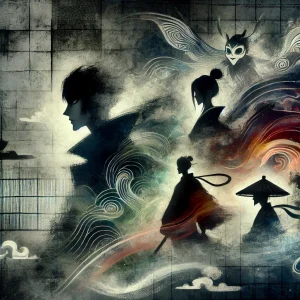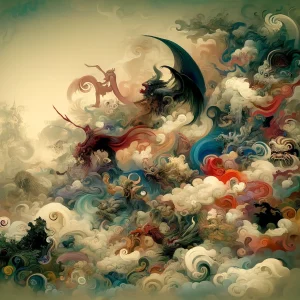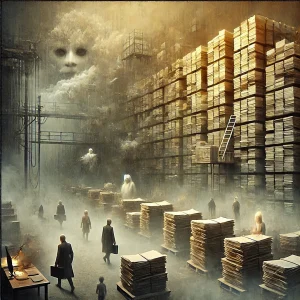If you’ve been following Hozuki's Coolheadedness, then you know that Part 2 of Season 2 takes the already absurd world of Hell and makes it even more entertaining. This continuation dives deeper into the bureaucratic nightmare that is the afterlife, with Hozuki managing everything from unruly spirits to high-level demonic politics. It’s a wild ride, but one filled with sharp wit and clever storytelling that fans of the series have come to expect.
So, what are the major plot points in Part 2? For starters, the story continues to focus on Hozuki as he navigates the chaotic operations of Hell. Whether he’s resolving conflicts between restless souls or dealing with the constant paperwork that piles up, Hozuki remains as unflappable as ever. One of the key plotlines in this part involves the ongoing tension between different realms of the afterlife. Hell isn’t just one big, fiery pit—it’s a complex system with its own rules, and Hozuki is right in the middle of keeping it all together. The political intrigue between different sections of Hell adds depth to the narrative, while also providing plenty of comedic moments.
But it’s not just about the plot. Hozuki's Coolheadedness thrives on its recurring themes, which Part 2 explores even more deeply. Take, for example, the theme of bureaucracy in Hell. This idea that even in the afterlife, paperwork and red tape are unavoidable is both hilarious and strangely relatable. Hozuki’s stoic approach to these challenges reflects the absurdity of modern-day life, where even the most mundane tasks can become nightmarish in their complexity.
Another recurring theme in Part 2 is the incorporation of Japanese folklore. The series continues to introduce viewers to a wide array of mythological creatures, each with their own quirks and personalities. From talking animals to legendary figures, these characters add a layer of cultural depth to the show, making it a unique blend of comedy and folklore. The way Hozuki's Coolheadedness brings these ancient stories to life, while simultaneously poking fun at them, is one of the show’s standout qualities.
And then there’s the satire. Part 2 doesn’t shy away from making light of modern-day life, whether it’s through commentary on workplace politics, social issues, or even human nature itself. The humor is sharp, sometimes biting, but always clever. It’s this balance of comedy and social commentary that keeps the series feeling fresh, even as it delves into the more ridiculous aspects of Hell.
In short, Hozuki's Coolheadedness Season 2 Part 2 takes everything fans loved about the first half of the season and cranks it up a notch. The plot continues to weave through the complex world of Hell, with recurring themes like bureaucracy, Japanese folklore, and modern-day satire keeping the story grounded, yet delightfully absurd. If you’re a fan of dark humor and clever storytelling, this continuation has plenty to offer.
Character Development in Part 2

If you've been following Hozuki's Coolheadedness, then you already know that character development is one of the series' strong suits. In Season 2 Part 2, we see some interesting shifts in the way characters like Hozuki, King Enma, and others interact with each other and their world. It’s not just about Hell’s bureaucracy anymore; this part dives deeper into their personalities and relationships, revealing layers of complexity that weren't as apparent before.
Let's start with Hozuki. He’s always been the cool-headed, no-nonsense type who handles Hell’s operations with unshakable calm. But in Part 2, we see more of his softer side, albeit in his own unique way. Whether it's his mentorship of the junior staff or his interactions with creatures from folklore, Hozuki’s character becomes more well-rounded. You start to notice that while he’s strict and efficient, there’s also a deep sense of responsibility that drives him. This balance between his tough exterior and underlying care for Hell's smooth functioning adds a new dimension to his character.
King Enma, on the other hand, shows some subtle evolution as well. Known for his easygoing and somewhat bumbling nature, he continues to serve as the perfect foil to Hozuki's stern demeanor. However, in Season 2 Part 2, we get glimpses of his leadership qualities, even if they're sometimes overshadowed by his humorous mistakes. Enma starts to show more awareness of the weight of his position, and while he may not always get it right, his moments of reflection add depth to his character. His growth isn’t drastic, but it’s enough to make you see him as more than just a comedic figurehead.
Now, about the new characters introduced in Part 2—they bring a fresh energy to the story. Each one adds something unique to the dynamic in Hell. For instance, some of the new arrivals challenge Hozuki’s methods, leading to moments of tension and humor. These characters aren’t just there for laughs; they help push the main cast into situations that force them to adapt and evolve. Their impact on the storyline can’t be ignored because they create new opportunities for character interactions and plot developments that keep the series feeling fresh.
What’s great about Hozuki's Coolheadedness is that it doesn’t rely on dramatic changes to show character growth. Instead, it uses subtle interactions, witty dialogue, and situational humor to peel back the layers of its characters. Whether it’s through Hozuki’s quiet sense of duty or King Enma’s evolving sense of responsibility, the development feels natural and engaging. Add to that the influence of the new characters, and you’ve got a continuation that not only entertains but also deepens your connection to the world of Hell.
In Season 2 Part 2, the characters aren’t just static; they’re living, evolving parts of this unique portrayal of the afterlife. Whether you’re laughing at their antics or catching a glimpse of their deeper struggles, the way these characters develop keeps you hooked from episode to episode.
Visual and Artistic Style

When it comes to Hozuki's Coolheadedness, one of the first things that catches your eye is the unique visual and artistic style. It’s not just about beautiful animation; the style plays a huge role in setting the tone of the series, balancing between the comedic and the dark. This blend of humor and eeriness is captured perfectly through the use of vibrant colors, traditional Japanese motifs, and detailed character designs that bring Hell to life in a way that’s both charming and unsettling.
Let’s talk about the animation. The series has this striking way of making Hell look almost… inviting. Yes, it's Hell, but the way it's depicted makes it feel more like a bustling, bureaucratic city rather than a place of eternal torment. The animators have carefully crafted the background art to resemble traditional Japanese art styles, particularly in the depiction of landscapes and mythical creatures. This artistic choice not only grounds the series in Japanese folklore but also gives the show a distinct visual identity. It’s hard not to be drawn in by the beauty of Hell’s various realms, even as you’re laughing at the ridiculous situations Hozuki finds himself in.
One thing that stands out is the contrast between the serene backgrounds and the sometimes chaotic events happening in the foreground. For example, in scenes where Hozuki is calmly handling paperwork amidst the swirling chaos of Hell’s operations, the background remains peaceful, almost meditative. This contrast heightens the comedy because it underscores just how unfazed Hozuki is by the madness around him. It’s a clever visual trick that adds to the humor without being over-the-top.
Specific episodes really highlight this balance between comedy and darkness. Take, for instance, the episode where Hozuki and his colleagues visit the animal realm of Hell. The landscape is lush and peaceful, filled with blooming cherry blossoms and tranquil rivers, yet the story itself is full of dark humor as Hozuki navigates the bureaucracy of animal spirits. The juxtaposition of the beautiful scenery with the grim subject matter creates a surreal, almost dreamlike atmosphere that’s both funny and thought-provoking.
Another memorable scene is when Hozuki faces off with rival spirits in Hell. The animation takes on a more dramatic, almost theatrical style, using shadows and bold colors to heighten the tension. Yet, even in these darker moments, there’s a certain playfulness to the animation. The exaggerated expressions and quick transitions from intense to humorous keep the tone light, reminding viewers that this is a series that never takes itself too seriously.
The character designs are another standout feature. Each character is meticulously crafted to reflect their personality. Hozuki’s stoic expression and sharp features mirror his no-nonsense attitude, while King Enma’s round, more comical appearance matches his more relaxed, bumbling nature. Even the minor characters get the same level of attention, ensuring that every scene is visually engaging.
Overall, the visual and artistic style of Hozuki's Coolheadedness plays a crucial role in enhancing both the comedic and dark elements of the series. Whether it’s the serene yet eerie landscapes or the expressive character designs, every visual detail contributes to the unique tone of the show.
Reception and Impact

When Hozuki's Coolheadedness Season 2 Part 2 aired, it quickly grabbed the attention of both Japanese and international audiences. In Japan, the series maintained its loyal fanbase, who appreciated its clever mix of dark humor and folklore. Many viewers found the continuation of Season 2 to be a satisfying return to the world of Hell, with more absurd yet thought-provoking stories about the afterlife. The way the show balances comedy with cultural references resonated well with Japanese audiences, who could easily recognize the subtle jokes and satirical takes on traditional myths.
Internationally, the reception was also positive, with many anime fans praising the series for its unique premise and sharp wit. For Western viewers, Hozuki's Coolheadedness provided a refreshing change from typical anime genres. The show’s deep dive into Japanese mythology and its portrayal of Hell as a bureaucratic nightmare appealed to those looking for something different. Even if some of the folklore references went over their heads, the humor and character dynamics were enough to keep them engaged. Fans on social media often highlighted how the show’s mix of absurdity and dry humor felt surprisingly relatable, despite the cultural differences.
One of the reasons for the show's growing popularity overseas is its cultural significance. Hozuki's Coolheadedness offers more than just entertainment; it serves as a window into Japanese folklore and traditions. The series introduces viewers to mythical creatures and legends that aren’t commonly depicted in mainstream anime, making it a fascinating watch for those interested in learning more about Japan’s cultural heritage. This cultural depth gives the show an edge, as it’s not only funny but also educational in a subtle way. Many international fans have expressed appreciation for the way the series showcases lesser-known aspects of Japanese culture, from the various interpretations of Hell to the small, everyday customs reflected in the characters' lives.
Another factor contributing to the show's success abroad is the rise of streaming platforms. With the availability of Hozuki's Coolheadedness on major streaming services, it has become accessible to a wider audience. Subtitles and localized content have allowed non-Japanese speakers to enjoy the series in its full glory, which in turn has boosted its global following. Anime conventions and fan communities also played a role in spreading the word about the show, further increasing its visibility among international fans.
Interestingly, the show’s satire of modern life struck a chord with audiences across different cultures. Whether it’s the portrayal of workplace politics in Hell or the bureaucracy that plagues even the afterlife, these themes are universal enough to resonate with viewers from all backgrounds. Fans often discuss how the show’s humor reflects their own experiences with bureaucracy and absurdity in daily life, making the series feel surprisingly relevant despite its fantastical setting.
In the end, Hozuki's Coolheadedness Season 2 Part 2 managed to capture the hearts of both Japanese and international audiences through its clever writing, cultural depth, and relatable humor. It’s a testament to the show’s unique blend of traditional folklore and modern-day satire that it continues to grow in popularity, even beyond Japan’s borders.





